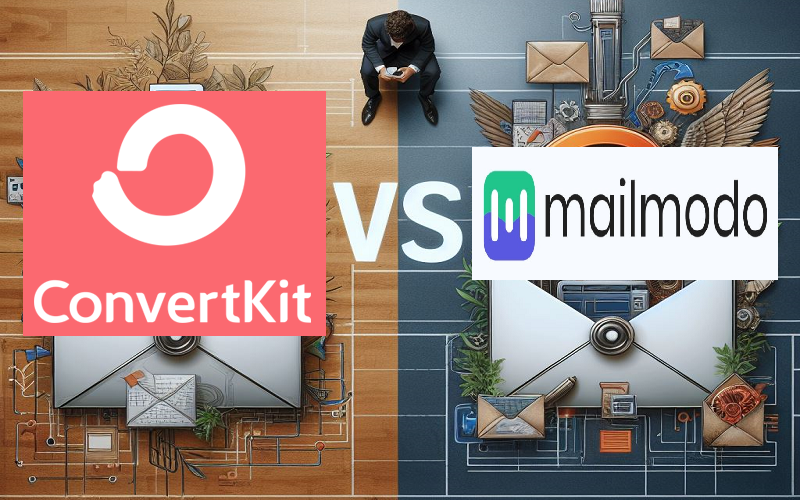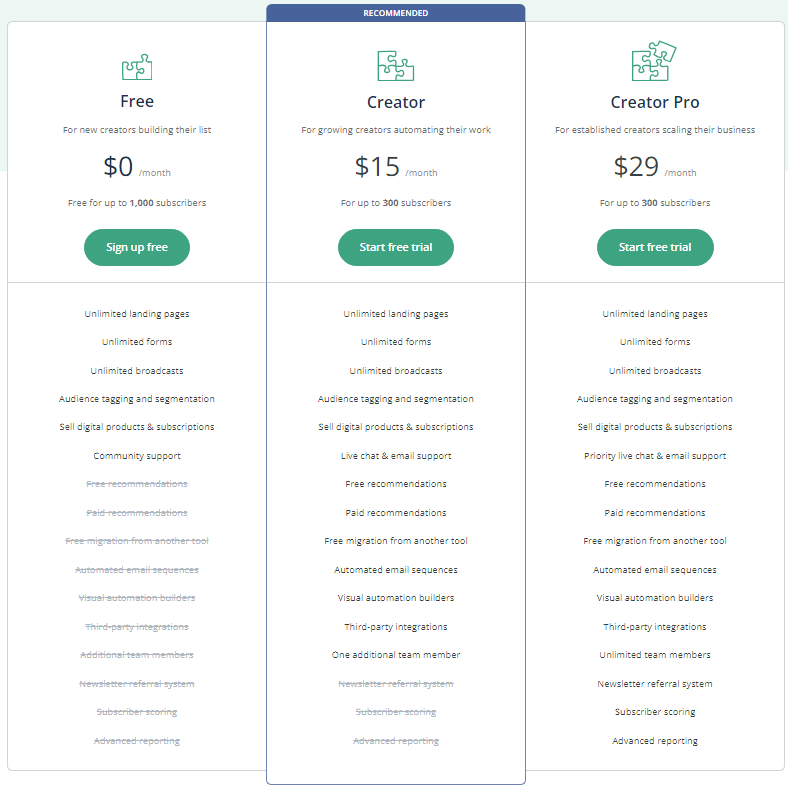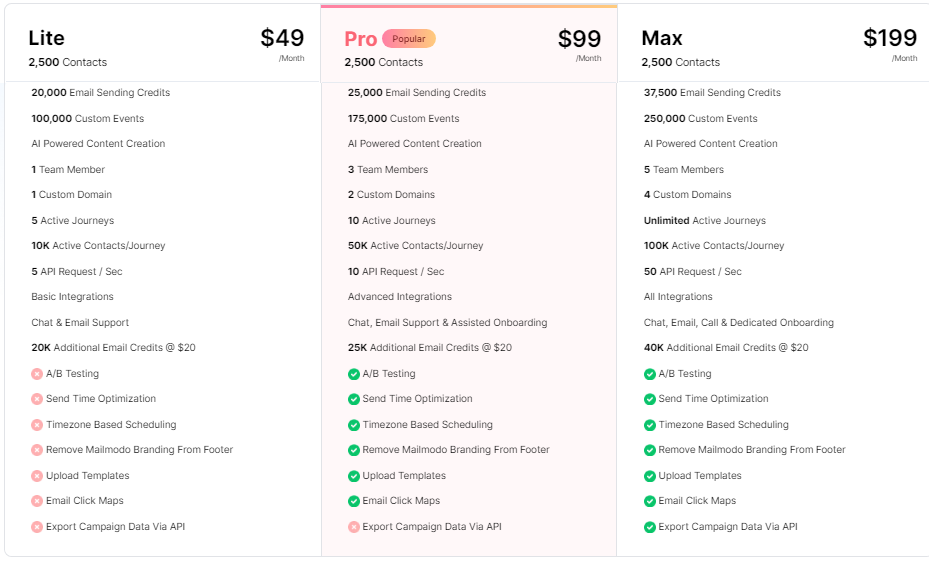Intro
Welcome to our in-depth exploration of two titans in the email marketing realm: ConvertKit and Mailmodo pricing. In this comprehensive analysis, we’ll delve into various aspects, with a particular focus on Mailmodo pricing. If you’re seeking the perfect email marketing solution, read on to make an informed decision.
Table of Contents
Quick Comparison
In this swift overview, we aim to distill the essence of the ConvertKit vs. Mailmodo rivalry, focusing on key aspects that could influence your decision-making process.
ConvertKit at a Glance
Pros:
- User-Friendly Interface: ConvertKit shines with its intuitive and user-friendly platform, making it accessible to marketers of all levels.
- Tagging and Segmentation: Precise audience targeting is a forte, ensuring tailored communication through robust tagging and segmentation features.
- Visual Automation Builder: The visual automation builder simplifies complex workflows, offering a streamlined approach to designing intricate customer journeys.
Cons:
- Limited E-commerce Integrations: While robust, native e-commerce integrations might be perceived as somewhat limited compared to competitors.
- Learning Curve for Advanced Features: Mastering advanced features like the visual automation builder may require some learning, particularly for users new to automation concepts.
Mailmodo in the Spotlight
Pros:
- AMP for Email Support: Mailmodo pricing stands out with its support for AMP for Email, allowing the creation of dynamic and interactive emails for a more engaging user experience.
- E-commerce Integrations: Native integrations with major platforms like WooCommerce and Magento cater to businesses with a strong online sales focus.
- AI-Driven Personalization: Leveraging artificial intelligence, Mailmodo pricing excels in delivering advanced personalization, analyzing user behavior for more targeted content delivery.
Cons:
- Learning Curve for AMP for Email: While innovative, utilizing AMP for Email may have a learning curve for users unfamiliar with this technology.
- Perceived Less Established Status: Mailmodo pricing might be perceived as less established compared to some industry giants, influencing user trust for certain businesses.
Your Decision Path
Consider this quick comparison as a compass pointing you in the direction of your ideal email marketing platform. The nuanced strengths and considerations highlighted here will guide you towards a decision that aligns seamlessly with your unique business goals and marketing strategies.
Features
The battle between ConvertKit and Mailmodo pricing in the email marketing arena revolves around their extensive feature sets. Let’s delve into the unique offerings of each platform, helping you understand which aligns better with your specific marketing needs.
ConvertKit’s Feature Highlights
- Visual Automation Builder: ConvertKit provides a visual automation builder, allowing users to create sophisticated automation workflows without the need for complex coding. This feature simplifies the process of designing intricate customer journeys.
- Tagging and Segmentation: ConvertKit excels in its tagging and segmentation capabilities. Users can easily segment their audience based on behavior, preferences, or engagement levels, ensuring targeted and personalized communication.
- Responsive Email Design: With a focus on aesthetics and functionality, ConvertKit enables users to create responsive and visually appealing email designs. This ensures a seamless experience for recipients, regardless of the device they use.
- Landing Pages: ConvertKit offers a simple yet effective landing page builder. Users can create customizable landing pages to capture leads and integrate them seamlessly into their marketing campaigns.
- A/B Testing: A/B testing is crucial for optimizing email campaigns. ConvertKit allows users to test different elements, such as subject lines or content, to determine the most effective strategies for audience engagement.
Mailmodo’s Pricing Unique Offerings
- AMP for Email: Mailmodo pricing stands out with its support for Accelerated Mobile Pages (AMP) for Email. This feature enables the creation of dynamic and interactive emails, providing a more engaging experience for recipients directly within the email client.
- E-commerce Integrations: Mailmodo takes integration to the next level, particularly for e-commerce businesses. With native integrations for major platforms like WooCommerce and Magento, users can seamlessly connect their email marketing efforts with their online stores.
- Interactive Forms: Mailmodo pricing empowers users to create interactive forms, enhancing user engagement and interactivity. These forms can be embedded in emails to collect valuable data and feedback from subscribers.
- AI-Driven Personalization: Leveraging artificial intelligence, Mailmodo pricing focuses on advanced personalization techniques. The platform analyzes user behavior to deliver content tailored to individual preferences, increasing the likelihood of engagement.
- Real-time Collaboration: Mailmodo pricing facilitates real-time collaboration among team members. This is particularly valuable for businesses with multiple stakeholders involved in the email marketing process, ensuring seamless communication and workflow efficiency.
Choosing the Right Features for Your Needs
When evaluating features, consider the specific requirements of your email marketing strategy:
- Automation Complexity: If you prioritize visual automation and simplicity, ConvertKit might be the ideal choice.
- Interactivity: If interactive and dynamic emails are crucial for your campaigns, Mailmodo’s AMP for Email could be a game-changer.
- E-commerce Focus: For businesses heavily involved in online sales, Mailmodo’s e-commerce integrations provide a tailored experience.
- Segmentation Precision: If precise audience segmentation is a top priority, ConvertKit’s tagging and segmentation features excel.
By aligning these features with your marketing goals, you can make an informed decision that ensures your chosen platform meets the specific demands of your email marketing campaigns.
Personal Experience
Drawing from personal encounters with ConvertKit and Mailmodo, we unveil insights that extend beyond features. Discover firsthand experiences to aid your decision-making process. Please also see my email marketing guide at: Email Marketing Guide 2023.
Pricing
The pricing structure of ConvertKit and Mailmodo pricing plays a crucial role in determining the feasibility and cost-effectiveness of each platform for your business. Let’s delve into the pricing details of both, highlighting key considerations to help you make an informed decision.
ConvertKit Pricing
ConvertKit adopts a straightforward pricing model – Figure 1.0 below – that is primarily based on the number of subscribers in your account. Here’s a brief overview:
Free: This plan is for new creators building their list. It is free for up to 1,000 subscribers. It includes unlimited landing pages, forms, broadcasts, audience tagging and segmentation, and the ability to sell digital products and subscriptions.
Creator: This plan is for growing creators automating their work. It starts from $9/month (billed annually) for up to 300 subscribers. It includes everything in the Free plan, plus automated email sequences, visual automation builders, third-party integrations, and one additional team member.
Creator Pro: This plan is for established creators scaling their business. It starts from $25/month (billed annually) for up to 300 subscribers. It includes everything in the Creator plan, plus newsletter referral system, subscriber scoring, advanced reporting, and unlimited team members.
You can find more details about each plan and compare their features on the ConvertKit website as per image link below in Figure 1.0.
Mailmodo Pricing
Mailmodo’s pricing – Figure 2.0 below – structure is designed to be flexible, catering to diverse business sizes and needs. Here’s an overview:
Lite: This plan is for new email marketers who want to create and send interactive emails. It costs $39/month (billed annually) for up to 2,500 contacts and 20,000 email sending credits. It includes unlimited landing pages, forms, broadcasts, audience tagging and segmentation, and the ability to sell digital products and subscriptions.
Pro: This plan is for growing email marketers who want to automate their work and optimize their campaigns. It costs $79/month (billed annually) for up to 2,500 contacts and 25,000 email sending credits. It includes everything in the Lite plan, plus A/B testing, send time optimization, timezone based scheduling, remove Mailmodo branding from footer, upload templates, email click maps, export campaign data via API, and more integrations.
Max: This plan is for established email marketers who want to scale their business and get advanced analytics. It costs $159/month (billed annually) for up to 2,500 contacts and 37,500 email sending credits. It includes everything in the Pro plan, plus newsletter referral system, subscriber scoring, advanced reporting, unlimited team members, and more integrations.
You can find more details about each plan and compare their features on the Mailmodo website as per image link below as Figure 2.0.
Considerations for Your Decision
When evaluating pricing, consider the following factors:
- Subscriber Growth: Assess how each platform’s pricing scales with the growth of your subscriber list.
- Feature Requirements: Evaluate whether the features offered in the free plans or entry-level paid plans meet your business requirements.
- Usage Patterns: If your email marketing needs vary seasonally or are project-based, a pay-as-you-go model may be advantageous.
By carefully considering these factors and aligning them with your business’s financial and operational considerations, you can make a pricing decision that optimally suits your email marketing strategy.
Pros & Cons
The decision between ConvertKit and Mailmodo pricing requires a careful examination of the strengths and weaknesses of each platform. Let’s dissect the pros and cons, helping you weigh the trade-offs and make an informed choice.
ConvertKit
Pros:
- User-Friendly Interface: ConvertKit is known for its user-friendly interface, making it accessible for beginners and seasoned marketers alike.
- Visual Automation Builder: The visual automation builder simplifies the creation of intricate workflows, enabling users to design complex customer journeys without coding.
- Tagging and Segmentation: Robust tagging and segmentation capabilities allow for precise audience targeting, ensuring personalized communication.
- Responsive Email Design: ConvertKit enables the creation of responsive and visually appealing email designs, optimizing the user experience across devices.
Cons:
- Limited E-commerce Integrations: Compared to some competitors, ConvertKit’s native e-commerce integrations may be perceived as limited.
- Learning Curve for Advanced Features: While user-friendly, mastering advanced features like the visual automation builder might require some learning for users new to automation concepts.
Mailmodo
Pros:
- AMP for Email Support: Mailmodo stands out with its support for AMP for Email, enabling the creation of dynamic and interactive emails for enhanced engagement.
- E-commerce Integrations: Native integrations for major e-commerce platforms, such as WooCommerce and Magento, cater to businesses with a strong online sales focus.
- Interactive Forms: Mailmodo’s interactive forms add an engaging element to email campaigns, fostering user interaction and data collection.
- AI-Driven Personalization: Leveraging artificial intelligence, Mailmodo pricing offers advanced personalization, analyzing user behavior for more targeted content delivery.
Cons:
- Learning Curve for AMP for Email: While a powerful feature, using AMP for Email might have a learning curve for users unfamiliar with this technology.
- Less Established than Competitors: Mailmodo pricing might be perceived as less established compared to some industry giants, influencing user trust for certain businesses.
Making Your Decision
Consider these pros and cons in the context of your specific needs and goals. If user-friendliness and a strong focus on segmentation are paramount, ConvertKit may be the better fit. On the other hand, if you prioritize interactive and dynamic email content, along with robust e-commerce integrations, Mailmodo pricing could be the ideal choice.
By evaluating these factors, you can determine which platform aligns best with your unique requirements and positions you for success in your email marketing endeavors.
Integrations
The power of integration cannot be overstated. ConvertKit and Mailmodo pricing both offer robust integration capabilities. ConvertKit seamlessly integrates with popular tools like Zapier, Shopify, and WordPress. This facilitates a smooth workflow, allowing you to connect your email marketing efforts with your other essential business processes effortlessly.
On the other hand, Mailmodo pricing takes integration to the next level with native integrations for major e-commerce platforms such as WooCommerce and Magento. This ensures a more tailored experience for businesses heavily involved in online sales.
Explore how these integrations align with your specific business needs, whether you’re focused on e-commerce, content management, or customer relationship management.
Deliverability
In the intricate landscape of email marketing, deliverability stands as a pivotal metric. Both ConvertKit and Mailmodo pricing prioritize ensuring your messages reach their intended recipients, yet the nuanced approaches can influence your overall email marketing success.
ConvertKit’s Deliverability Strategy
ConvertKit employs sophisticated algorithms and best practices to optimize email delivery. With a keen focus on providing value to subscribers, ConvertKit encourages user engagement through personalized content and targeted messaging. This strategy often results in higher open rates and improved email deliverability.
Key features contributing to ConvertKit’s strong deliverability include:
- Subscriber Segmentation: ConvertKit allows users to segment their subscribers based on various factors, ensuring that emails are tailored to specific audience segments.
- Automation Rules: Automated sequences in ConvertKit can be customized to deliver content based on user actions, fostering engagement and relevance.
- Responsive Support: ConvertKit offers responsive customer support to address any deliverability issues promptly, ensuring a smooth experience for users.
Mailmodo’s AI-Driven Deliverability Approach
Mailmodo pricing takes a unique approach to deliverability, leveraging artificial intelligence (AI) to enhance message distribution. The platform’s AI algorithms analyze user behavior and engagement patterns, adapting the delivery strategy to optimize inbox placement and minimize the likelihood of emails being marked as spam.
Key aspects of Mailmodo’s deliverability strategy include:
- Behavioral Analytics: Mailmodo’s AI analyzes recipient behavior, ensuring that emails are sent at times when users are most likely to engage.
- Spam Avoidance: Through continuous learning, Mailmodo’s AI adapts to changes in spam filters, reducing the chances of emails being flagged as spam.
- Personalization Techniques: Mailmodo pricing emphasizes personalized content, increasing user engagement and positively impacting deliverability rates.
Digging Deeper into Deliverability Metrics
When evaluating deliverability, consider the following metrics for both platforms:
- Inbox Placement Rates: Determine the percentage of emails that successfully land in recipients’ inboxes, providing insights into the platforms’ effectiveness in bypassing spam filters.
- Spam Complaint Rates: Analyze the frequency at which recipients mark emails as spam. Low spam complaint rates indicate that the content resonates with the audience.
- Open Rates: Assess how often subscribers open emails, indicating the relevance and appeal of the content.
- Bounce Rates: Evaluate the rate at which emails cannot be delivered successfully. Low bounce rates signify a clean and well-maintained subscriber list.
Understanding these metrics will empower you to make an informed decision based on your specific deliverability needs and expectations.
Data Protection
In the realm of email marketing, safeguarding sensitive data is not just a necessity but a legal obligation. Both ConvertKit and Mailmodo pricing prioritize data protection, implementing measures to ensure the confidentiality, integrity, and availability of your business and customer information.
ConvertKit’s Data Protection Measures
ConvertKit adheres to stringent data protection regulations and industry best practices to secure user data. Here are key aspects of ConvertKit’s approach to data protection:
- End-to-End Encryption: ConvertKit employs end-to-end encryption, ensuring that data is securely transmitted and can only be accessed by authorized parties.
- Secure Storage: User data is stored securely, with robust measures in place to prevent unauthorized access. ConvertKit follows industry standards for data storage security.
- Regular Security Audits: ConvertKit conducts regular security audits to identify and address potential vulnerabilities. This proactive approach ensures a secure environment for user data.
- Compliance with Regulations: ConvertKit is committed to compliance with data protection regulations such as GDPR. Users can trust that their data is handled in accordance with the highest privacy standards.
Mailmodo’s Commitment to Data Security
Mailmodo places a strong emphasis on data security, implementing comprehensive measures to protect user information. Here’s an overview of Mailmodo’s data protection strategies:
- Regular Compliance Checks: Mailmodo conducts regular compliance checks to ensure adherence to data protection regulations. This includes staying updated on evolving privacy laws and making necessary adjustments.
- Data Encryption Protocols: Mailmodo employs robust encryption protocols to safeguard data during transmission and storage. This ensures that sensitive information remains confidential and secure.
- Access Controls: Mailmodo pricing implements strict access controls, allowing only authorized personnel to access and manage user data. This helps prevent unauthorized disclosure or tampering.
- Audit Trails: The platform maintains detailed audit trails, providing a record of who accessed the data and when. This transparency enhances accountability and aids in identifying and addressing potential security issues.
Evaluating Data Protection Features
When assessing data protection features, consider the following elements for both platforms:
- Encryption Standards: Understand the encryption standards used for data transmission and storage.
- Access Controls: Review the mechanisms in place to control and monitor access to sensitive information.
- Compliance Certifications: Check for certifications or compliance statements indicating adherence to privacy regulations.
- Data Handling Policies: Familiarize yourself with the platforms’ policies regarding data handling, retention, and deletion.
By examining these aspects, you can make an informed decision regarding the data protection capabilities of ConvertKit and Mailmodo, ensuring that your business complies with privacy regulations and your customers’ information remains secure.
Alternatives
While ConvertKit and Mailmodo pricing showcase impressive capabilities, exploring alternatives is a prudent approach to ensure you find the perfect fit for your email marketing needs. Here are some noteworthy alternatives to consider:
ActiveCampaign
Known for its robust automation features, ActiveCampaign goes beyond traditional email marketing, offering a comprehensive platform for marketing automation, sales automation, and customer relationship management (CRM). If you seek an all-in-one solution with advanced automation capabilities, ActiveCampaign might be the right choice.
MailerLite
For businesses on a budget without compromising on features, MailerLite is a compelling alternative. It provides a user-friendly interface, powerful automation tools, and competitive pricing, making it an excellent choice for small to medium-sized businesses.
AWeber
AWeber is a veteran in the email marketing space, boasting a user-friendly interface and reliable email deliverability. With features like automation, segmenting, and analytics, AWeber is a solid choice for businesses looking for a straightforward yet powerful email marketing solution.
Brevo
For businesses focused on personalization and dynamic content, Brevo stands out. It offers advanced personalization features, AI-driven recommendations, and real-time content updates, making it an ideal choice for those prioritizing tailored communication with their audience.
Constant Contact
Constant Contact is known for its ease of use and a wide range of templates. If you prioritize simplicity and effective communication, especially for small businesses and non-profits, Constant Contact could be the right alternative.
Keap
Formerly known as Infusionsoft, Keap is a comprehensive CRM and marketing automation tool. Ideal for small businesses, Keap streamlines customer management, lead generation, and marketing automation in one platform.
Emercury
Emercury offers advanced deliverability features and a robust automation platform. If email deliverability is a top concern for your business, exploring Emercury as an alternative is worthwhile.
Benchmark Email
Benchmark Email is a user-friendly option with drag-and-drop email design and automation features. It’s a solid choice for businesses seeking an intuitive platform without compromising on essential email marketing functionalities.
Explore these alternatives based on your specific business needs, budget constraints, and desired features to make a well-informed decision for your email marketing strategy.
Conclusion and Verdict
The showdown between ConvertKit and Mailmodo has unraveled a plethora of features, considerations, and nuances in the realm of email marketing. As we conclude our comprehensive comparison, let’s distill the insights to guide you towards the platform that aligns seamlessly with your unique needs and goals.
ConvertKit: The Reliable Workhorse
Strengths:
- User-Friendly Interface: ConvertKit stands out for its intuitive and user-friendly interface, making it accessible to marketers with varying levels of experience.
- Tagging and Segmentation Mastery: Precise audience targeting through robust tagging and segmentation capabilities is a forte of ConvertKit, ensuring personalized communication.
- Visual Automation Builder: The visual automation builder simplifies complex workflows, offering a streamlined approach to designing intricate customer journeys.
Considerations:
- Limited E-commerce Integrations: Businesses heavily invested in e-commerce might find ConvertKit’s native integrations relatively limited compared to competitors.
- Learning Curve for Advanced Features: While user-friendly, mastering advanced features like the visual automation builder might have a learning curve for users new to automation concepts.
Mailmodo: The Innovation Trailblazer
Strengths:
- AMP for Email Support: Mailmodo’s support for AMP for Email sets it apart, allowing marketers to create dynamic and interactive emails for a more engaging user experience.
- E-commerce Integrations: Native integrations with major e-commerce platforms like WooCommerce and Magento cater to businesses with a strong online sales focus.
- AI-Driven Personalization: Leveraging artificial intelligence, Mailmodo pricing excels in delivering advanced personalization, analyzing user behavior for more targeted content delivery.
Considerations:
- Learning Curve for AMP for Email: While a powerful feature, utilizing AMP for Email may have a learning curve for users unfamiliar with this technology.
- Perceived Less Established Status: Mailmodo might be perceived as less established compared to some industry giants, influencing user trust for certain businesses.
Your Verdict: Tailoring to Your Unique Needs
The choice between ConvertKit and Mailmodo ultimately hinges on your specific business requirements, priorities, and the intricacies of your email marketing strategy.
- Choose ConvertKit If:
- You prioritize a user-friendly interface and straightforward user experience.
- Precise audience segmentation is a critical element of your marketing strategy.
- You value a visual automation builder for designing complex workflows with ease.
- Choose Mailmodo If:
- You seek innovation, especially with the support for AMP for Email and interactive content.
- E-commerce integrations are pivotal for your business, and you require native support for major platforms.
- Advanced personalization through AI aligns with your strategy for targeted content delivery.
The Final Verdict
Both ConvertKit and Mailmodo pricing have carved their niches in the competitive landscape of email marketing. Your decision should be informed by a holistic understanding of your business objectives, budget constraints, and the specific features that will elevate your email marketing efforts.
As you embark on this decision-making journey, carefully weigh the pros, cons, and unique strengths of each platform. Whether you opt for the reliability of ConvertKit or the innovation of Mailmodo, your chosen platform should seamlessly integrate with your vision, enabling you to craft compelling email campaigns that resonate with your audience and drive meaningful results.
In the grand finale of this comparison, the verdict is in your hands. May your chosen email marketing platform propel your business to new heights of success and engagement.
Ready to elevate your email marketing game? Click below to try your preferred product:







